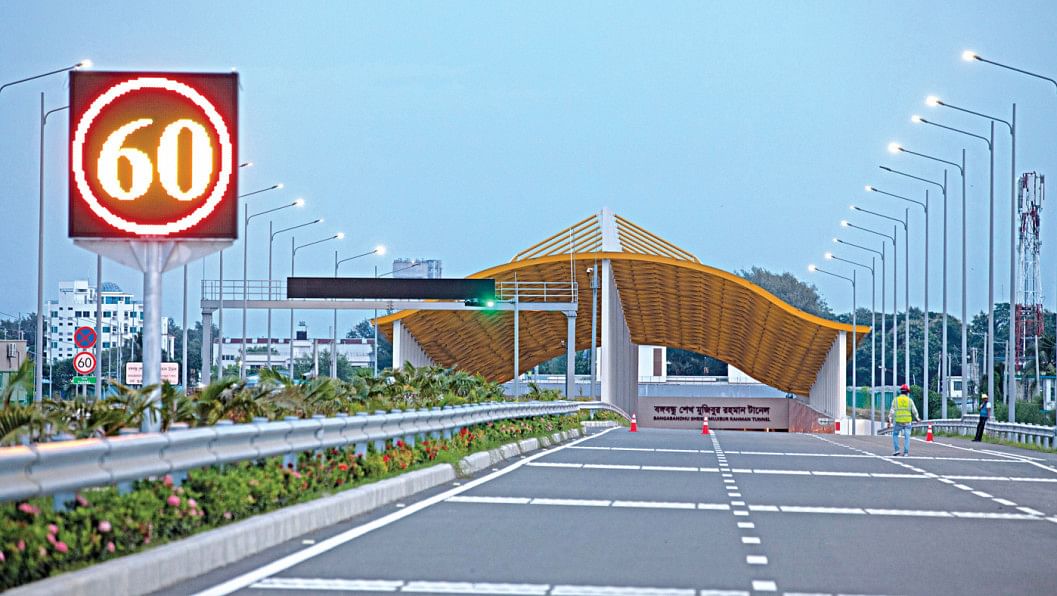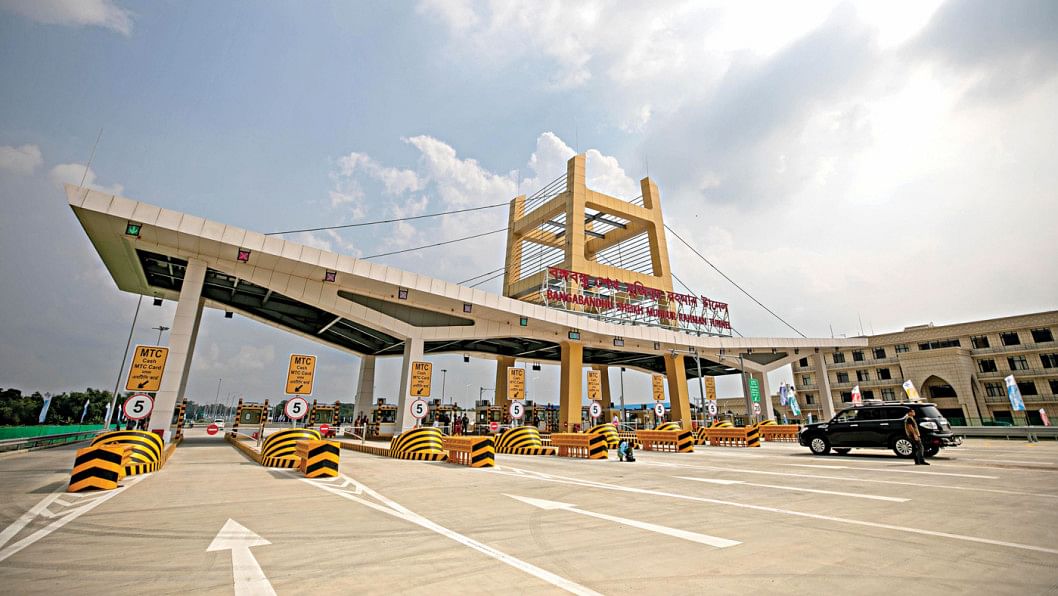Bangabandhu Tunnel Dream becomes reality
The inauguration of the Bangabandhu Tunnel by the prime minister today carries high hopes, with experts and locals anticipating that it will transform Chattogram into a city resembling Shanghai and boost industrial growth in the port city.
This river tunnel, constructed in alignment with China's "one city - two towns" concept, goes under the Karnaphuli river, connecting Patenga in the port city to Anwara upazila on the opposite bank.
Vigorous economic activities and industrialisation have already begun on both sides of the river, centring the tunnel's opening. The tunnel is also South Asia's inaugural river tunnel.
The tunnel is also expected to play a vital role in expanding the potential tourism sector in Cox's Bazar and Chattogram Hill Tracts.
The tunnel has been constructed at a depth of 18 to 31 metres under the river. The length of the main tunnel is 3.32km, while each of the two tubes with four lanes is 2.45 km long. There is also a 5.35 km connecting road at the west and east ends of the main tunnel and a 727m over-bridge at the Anwara end.
A NEW ERA OF INDUSTRIALISATION
Numerous industries and businesses have been established in Anwara upazila centering the tunnel, with 15 large industrial groups and 200 businesspeople buying land to set up plants across sectors like power, petroleum, apparel, shipbuilding, fish processing, steel, cement, and oil refinery on the south bank of Karnaphuli, said Noab Ali, chairman of Boirag union parishad in the upazila.
"We expect the tunnel will transform the upazila and entire southern Chattogram," he said.
Contacted, Prof Dr Mainul Islam, former professor of economics department at Chittagong University, said the tunnel would bring an opportunity to develop a new township on the south bank of the Karnaphuli, but proper planning is a must to implement it.
Mainul, also former president of Bangladesh Economics Association, said, "Developing Chattogram as 'one city-two towns' is not a utopian concept, rather I have been writing for developing the south bank of the Karnaphulli as a hub of tourism, industrial and residential zones through my columns and articles for 40 years."

Nasir Uddin Chowdhury, former first vice-president of Bangladesh Garments Manufacturers and Exporters Association (BGMEA), echoed the same.
"A combined planning is required to utilise the opportunity the tunnel has brought to us," he said.
"Industrialisation and economic activities are expected to boom on the south bank of the river, thanks to the tunnel's connectivity," he added.
MA Kyum Shah, chairman of Baaroshot union parishad in Anwara upazila, said the authorities should also take steps to develop proper drainage, waste management and traffic control systems in the upazila, adding that residents will otherwise suffer.
HOW THE DREAM TURNED INTO REALITY
It was former Chattogram mayor ABM Mohiuddin Chowdhury who first demanded the government to build a tunnel under the Karnaphuli back in 2005.
The then government initially had a plan to build the third Karnaphuli bridge, as the second one was in a dilapidated state.
Mohiuddin demanded that the government either build a hanging bridge or a tunnel under the river, said Sheikh Iftekher Saimul Chowdhury, public prosecutor at Chattogram District Judge's Court.
Mohiuddin opposed building any sort of pillar-bridge on the river, arguing it would spoil its navigability by causing siltation and ultimately Chattogram Port would have to bear the brunt, said Saimul, also law affairs secretary of Chattogram city unit Awami League.
"Under ABM Mohiuddin's leadership, we organised a series of movements in this regard. However, the then government did not pay heed to our demand and started building a pillar-bridge on Karnaphuli River in August 2006," he said.
A decade later, Prime Minister Shiekh Hasina and Chinese President Xi Jinping jointly laid the foundation stone of Karnaphuli tunnel on October 14, 2016. On February 24, 2019, PM Sheikh Hasina inaugurated the boring works of the tunnel.
Earlier in November 2015, the Executive Committee of the National Economic Council (Ecnec) approved the multi-lane tunnel project at a cost of Tk 8,446.64 crore, slated to be completed by December 2021.
The cost was later increased to Tk 10,374.42 crore, while the project period was extended to December 2022.
In the latest revision, the project duration was further extended till December 30, 2023, while the cost went up yet again by Tk 315 crore.
China Exim Bank gave a loan of Tk 5,913 crore, while Bangladesh government funded the rest.

The tunnel has been constructed at a depth of 18 to 31 metres under the river. The length of the main tunnel is 3.32km, while each of the two tubes with four lanes is 2.45 km long. There is also a 5.35 km connecting road at the west and east ends of the main tunnel and a 727m over-bridge at the Anwara end.
China Communication Construction Company Ltd constructed the tunnel.
According to the feasibility study report for the tunnel in 2013, about 7.46 million vehicles will be able to travel through the tunnel annually, with about 20,719 vehicles running daily.
An average of 28,305 vehicles will travel through the tunnel every day by 2025, 37,946 by 2030 and 162,000 by 2067.
The main tunnel could be crossed in just three minutes, said Mohammad Tofazzel Hossain Miah, principal secretary to prime minister, during a visit to the project site recently.

 For all latest news, follow The Daily Star's Google News channel.
For all latest news, follow The Daily Star's Google News channel. 



Comments